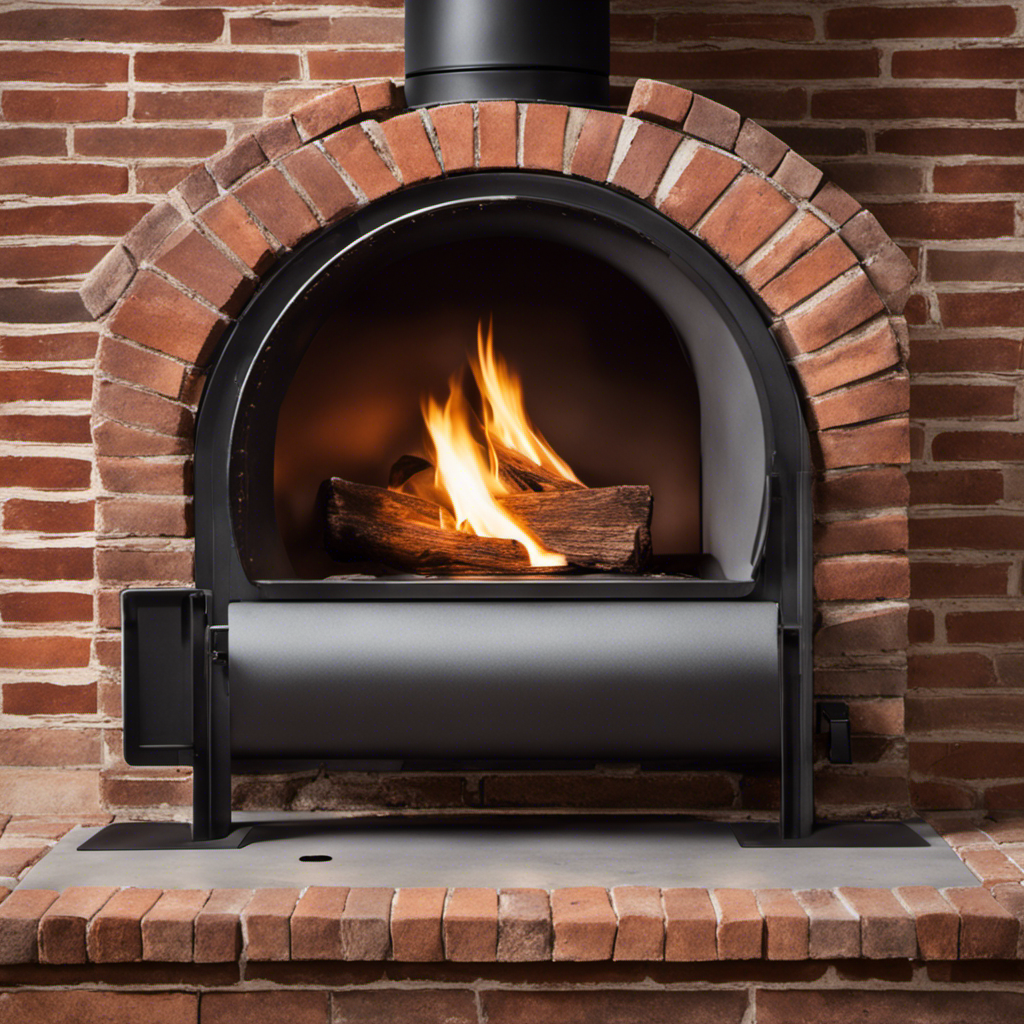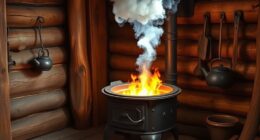Were you aware that if a wood stove isn’t utilized properly, as much as 30% of the heat it generates can dissipate into thin air? Ensure you’re not letting that precious warmth slip away!
In this article, I’ll share my expert tips on how to get the most heat out of your wood stove. From understanding efficiency to maximizing airflow, choosing the right wood, and proper maintenance, you’ll learn everything you need to keep your home cozy and warm all winter long.
Key Takeaways
- Proper insulation, such as firebricks and refractory cement, prevents heat loss and ensures generated heat stays inside the wood stove.
- Maximizing airflow through regular cleaning and checking for obstructions in the flue or chimney enhances heat output and combustion efficiency.
- Choosing dry and seasoned wood with lower moisture content improves combustion efficiency and increases heat output.
- Proper wood stove placement, including placing it closer to the center of the room and using heat shields, optimizes heat distribution and prevents fire hazards.
Understanding Wood Stove Efficiency
How can I improve the efficiency of my wood stove?
One way to increase efficiency is by focusing on wood stove insulation and improving combustion efficiency. Proper insulation is crucial in preventing heat loss and ensuring that the generated heat stays inside the stove. Insulation materials like firebricks and refractory cement can help retain heat and distribute it evenly.
Additionally, improving combustion efficiency can also boost the stove’s efficiency. This can be achieved by using dry and seasoned wood, which burns more efficiently and produces less smoke. It’s also essential to ensure proper airflow by cleaning the stove regularly and checking for any obstructions in the flue or chimney.
By addressing wood stove insulation and improving combustion efficiency, you can maximize the heat output and make your wood stove more efficient overall.
Now, let’s explore how to maximize airflow for optimal heat.
Maximizing Airflow for Optimal Heat
I can increase the heat output of my wood stove by ensuring proper airflow throughout the system. Here are some tips to help you maximize airflow and get the most heat out of your wood stove:
-
Improving insulation for better heat retention: Insulating your stove and chimney can help prevent heat loss and ensure that more heat is directed into your living space.
-
Using a heat powered stove fan for increased airflow: These fans are designed to circulate the warm air produced by your wood stove, distributing it more effectively throughout the room.
-
Keeping the air vents open: Make sure the air vents on your stove are fully open to allow for a steady flow of oxygen, which is essential for efficient combustion and optimal heat output.
-
Cleaning the chimney regularly: A clean chimney ensures proper airflow and prevents the buildup of creosote, which can reduce the efficiency of your stove.
By following these tips, you can enhance the airflow in your wood stove and enjoy a higher heat output.
Now, let’s move on to the next section and discuss the importance of choosing the right wood for maximum heat output.
Choosing the Right Wood for Maximum Heat Output
I can optimize the heat output of my wood stove by carefully selecting the type of wood I burn. The wood species I choose and its moisture content have a significant impact on the amount of heat produced. Different wood species have varying levels of density and energy content, which directly affect their heat output. Additionally, the moisture content of the wood greatly influences its combustion efficiency. Wet or green wood contains high moisture levels, which results in a lower heat output as a significant amount of energy is used to evaporate the water. To illustrate the impact of wood species and moisture content on heat output, refer to the table below:
| Wood Species | Heat Output (BTUs per cord) | Moisture Content (%) |
|---|---|---|
| Oak | 26,000 | 20% |
| Pine | 18,000 | 50% |
| Ash | 24,000 | 15% |
| Maple | 22,000 | 25% |
| Birch | 20,000 | 30% |
Proper Wood Stove Placement for Heat Distribution
Placing the wood stove closer to the center of the room and using a heat shield can help improve heat distribution. By doing so, you ensure that the warmth radiates evenly throughout the space, maximizing comfort and efficiency.
Here are some wood stove safety precautions and insulating tips to consider:
- Keep a clear area around the stove to prevent any potential fire hazards.
- Install a carbon monoxide detector nearby to ensure safe indoor air quality.
- Use fire-resistant materials, such as a heat shield or ceramic tiles, to protect walls and floors from excessive heat.
- Insulate your home properly to prevent heat loss and optimize the stove’s performance.
By implementing these measures, you can enjoy a more comfortable and safe wood stove experience while efficiently heating your home.
Now, let’s delve into essential maintenance tips for peak performance.
Essential Maintenance Tips for Peak Performance
As I inspect the wood stove, I realize that regular cleaning and proper airflow are crucial for maintaining its peak performance.
Regular cleaning of the wood stove is essential to remove any built-up creosote, ashes, and debris that can block airflow and reduce its efficiency. It’s important to clean the stove’s interior, including the firebox, baffle, and flue, as well as the exterior surfaces.
Additionally, chimney maintenance is vital to ensure proper ventilation and prevent potential hazards. Regular chimney inspections and cleanings are necessary to remove any creosote buildup or blockages that can cause poor airflow or even chimney fires.
Frequently Asked Questions
Can a Wood Stove Be Used as the Primary Source of Heat in a Home?
Yes, a wood stove can be used as the primary source of heat in a home. However, it’s important to consider wood stove efficiency and explore alternative heating options to maximize heat output and minimize energy consumption.
What Are Some Common Mistakes People Make When Using a Wood Stove?
Common mistakes when using a wood stove include neglecting regular maintenance, overloading the stove with wood, and not using proper safety precautions. It’s important to prioritize safety and follow guidelines for optimal heat output.
How Can I Prevent Creosote Buildup in My Wood Stove?
To prevent creosote buildup in my wood stove, regular maintenance is key. Cleaning the chimney, using dry and seasoned wood, and ensuring proper airflow will help maximize heat output and minimize the risk of creosote accumulation.
Is It Necessary to Have a Chimney for a Wood Stove?
No, a chimney is not necessary for a wood stove. There are chimney alternatives available, such as vent pipes or direct vent systems. These chimney-less wood stoves offer benefits like increased efficiency and flexibility in installation.
Are There Any Safety Precautions I Should Take When Using a Wood Stove?
When using a wood stove, it’s important to take safety precautions. Make sure to keep flammable materials away, use a fire-resistant barrier, and install a carbon monoxide detector. Consider alternative heating options for added safety.
Conclusion
So, there you have it, folks. After all this talk about maximizing heat output and efficiency, it turns out that the best way to get the most heat out of a wood stove is to simply avoid using it altogether.
Yes, you heard that right – the secret to getting the most heat is to not use the stove at all. Who’d have thought? But hey, at least now you have some interesting knowledge to share at your next bonfire.
Stay warm, or not, I guess.
Growing up surrounded by the vast beauty of nature, Sierra was always drawn to the call of the wild. While others sought the comfort of the familiar, she ventured out, embracing the unpredictable and finding stories in the heartbeat of nature.
At the epicenter of every remarkable venture lies a dynamic team—a fusion of diverse talents, visions, and passions. The essence of Best Small Wood Stoves is crafted and refined by such a trio: Sierra, Logan, and Terra. Their collective expertise has transformed the platform into a leading authority on small wood stoves, radiating warmth and knowledge in equal measure.











